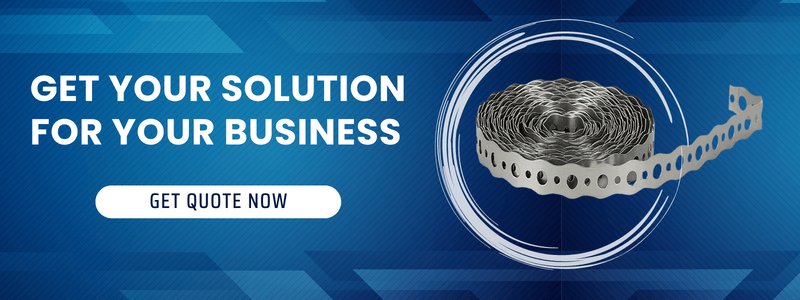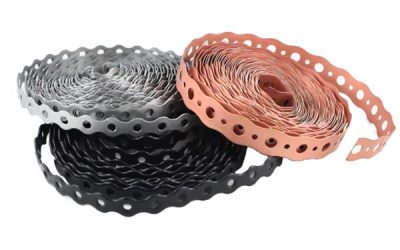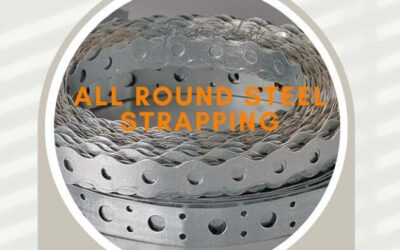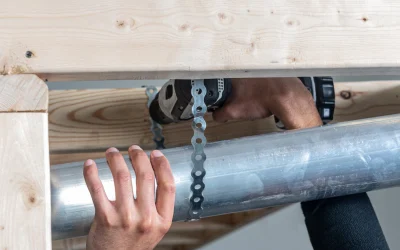In the intricate world of construction, plumbing, and HVAC systems, there’s a hero that often goes unsung – the galvanized hanger strap. This unassuming piece of hardware plays a pivotal role in ensuring the stability and longevity of various installations. In this article, we’ll delve into the multifaceted aspects of galvanized hanger straps, shedding light on their structure, purpose, usage, and inherent strengths.
An Overview of Galvanized Hanger Straps
Galvanized hanger straps, often referred to as plumber’s tape or perforated metal straps, are ubiquitously used in construction projects worldwide. They are robust, flexible strips usually made from steel and coated with zinc through a process known as galvanization. This treatment gives the straps their trademark name and confers several advantageous properties, such as resistance to rust and corrosion, thereby making them ideal for a variety of applications.
The Making of Galvanized Hanger Straps
Galvanized hanger straps are the product of marrying steel’s strength with zinc’s resilience. The steel base provides the strap with the needed durability and tensile strength, while the zinc coating shields the steel from corrosive substances that could compromise its integrity over time. This galvanizing process involves dipping the steel in molten zinc, which reacts with the steel’s surface to form an impermeable layer of zinc carbonate. The result is a robust and corrosion-resistant hanger strap, ready to stand the test of time.
Purpose of Galvanized Hanger Straps
Galvanized hanger straps are instrumental in various industries due to their durability, strength, and flexibility.
Plumbing Applications
In the realm of plumbing, galvanized hanger straps are a favorite tool for suspending pipes from joists and rafters. They offer the strength necessary to support heavy copper, PVC, or steel pipes, while their flexibility allows for easy adaptation to different pipe sizes and installation configurations.
HVAC Applications
In the HVAC sector, galvanized hanger straps come into play for suspending ductwork and other system components. Their rust-resistance makes them an ideal choice for this application, as HVAC systems often expose materials to moisture and temperature fluctuations.

The Proper Usage of Galvanized Hanger Straps
While galvanized hanger straps are impressively versatile, their correct use is paramount to ensure the stability and safety of the installations they support.
Measurement and Cutting
The first step in using galvanized hanger straps is to accurately measure the distance between the mounting points where the strap will be attached. This measurement guides the length of the strap that needs to be cut. It’s vital to allow for additional length that will wrap around the pipe or duct and to secure the strap ends to the mounting points.
Installation Process
Once cut, the strap wraps around the object, ensuring a snug fit but not too tight as to constrict any movement due to thermal expansion or contraction. The ends of the strap are then secured to the mounting points using suitable fasteners, often screws or nails. The result is a secure and stable support system.
Cutting Galvanized Hanger Straps
Successfully cutting galvanized hanger straps requires specific tools and a careful approach to ensure a clean, safe cut.
Necessary Tools
A pair of heavy-duty scissors, tin snips, or a hacksaw are usually the go-to tools for cutting these straps. While scissors may suffice for thinner straps, tin snips or a hacksaw are better suited to handle thicker or multiple straps.
Cutting Steps
After marking the required length on the strap, align the cutting tool along the marked line, applying steady pressure to ensure a clean cut. It’s essential to handle the cut edges with care as they can be sharp and potentially cause injury.
Assessing the Strength of Galvanized Hanger Straps
One of the main advantages of galvanized hanger straps is their impressive strength, making them ideal for supporting heavy loads.
Tensile Strength
Tensile strength refers to the maximum amount of tensile (pulling) stress that a material can withstand without breaking. Thanks to their steel composition, galvanized hanger straps boast a high tensile strength, allowing them to resist breaking or deformation even when subjected to significant stress.
Load-bearing Strength
Alongside tensile strength, the load-bearing strength of these straps, referring to the maximum load they can support, is equally impressive. This feature, combined with their corrosion resistance, makes them a reliable choice for heavy-duty applications in construction, plumbing, and HVAC installations.
Working with Galvanized Pipe Hanger Straps
While galvanized hanger straps have a wide range of applications, they’re often used specifically with pipes, offering a few additional benefits in these scenarios.
Application Process
The process of using galvanized pipe hanger straps is similar to the standard use of hanger straps. Measure, cut, wrap, and secure – the key steps remain the same. However, pipe hanger straps often come with pre-punched holes for fasteners, making the installation process even more straightforward.
Longevity in Corrosive Environments
The galvanizing process lends these straps a high resistance to moisture and other corrosive elements. Therefore, even in environments that would typically spell doom for steel, galvanized pipe hanger straps thrive, guaranteeing a longer lifespan for the pipes they support.
Advantages of Galvanized Hanger Strap
The benefits of galvanized hanger straps extend beyond their strength and durability. They are incredibly versatile, being bendable to fit a multitude of configurations. They’re also cost-effective, providing a reliable, long-lasting solution at an affordable price. Lastly, they are relatively easy to use, making them a practical choice even for DIY enthusiasts.
Conclusion
In the panorama of construction and HVAC installations, galvanized hanger straps truly shine. Their unique blend of strength, durability, versatility, and affordability makes them an invaluable asset. They might be unsung heroes, but their importance in ensuring the structural integrity of various installations cannot be overstated.
FAQs
- What materials are used to make galvanized hanger straps? Galvanized hanger straps are made from steel and coated with a protective layer of zinc.
- What tools can you use to cut galvanized hanger straps?
Heavy-duty scissors, tin snips, or a hacksaw can be used to cut galvanized hanger straps. - What attributes contribute to the strength of galvanized hanger straps?
The tensile and load-bearing strength of the steel and the resilience provided by the zinc coating contribute to the overall strength of galvanized hanger straps. - Are galvanized hanger straps suitable for pipe installations?
Yes, galvanized hanger straps are often used to hang pipes and resist moisture and corrosive environments due to the galvanization process. - Why should I use galvanized hanger straps?
Galvanized hanger straps are durable, rust-resistant, versatile, and affordable. They’re suitable for heavy-duty applications and are easy to use.
Galvanized Steel Strapping vs Stainless Steel Strapping: A Comprehensive Comparison
Introduction When it comes to securing and bundling materials, steel strapping is a popular choice due to its strength, durability, and versatility. However, not all steel strapping is created equal. Two of the most widely used options are galvanized steel strapping...
How To Install All Round Steel Strapping?
If you're in the construction or plumbing industry, you know that hanging pipes securely is crucial for a successful installation. One of the most reliable methods for supporting pipes is using all round steel strapping, also known as banding. This versatile material...
28-Gauge Galvanized Pipe Hanger Strap: The Unsung Hero of Plumbing Installations
Introduction Have you ever stopped to think about the unsung heroes that hold your plumbing system together? Those unassuming yet essential components that ensure your pipes stay securely in place? Well, let me introduce you to the humble 28-gauge galvanized pipe...

Justin Wong
Hi, I’m Justin, the technical engineer of Jiangmen Masters. We’ve been running a factory in China that makes metal hanger strap for 16 years now, and the purpose of this article is to share the knowledge related to metal hanger strap from a Chinese supplier’s perspective.




